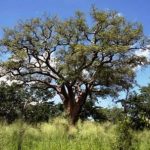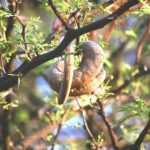TREE LIFE
April 2000
Subs ($120) are due on 1st April. Please use the invoice attached to this Tree Life when making payment, indicating if your address has changed.
While the present fuel crisis persists please check with any of the committee members to ensure that the scheduled outings and walks will actually take place.
MASHONALAND CALENDAR
Tuesday 4th April. Botanic Garden Walk at 4.45 for 5 p.m. The topic will be that lovely and interesting aromatic family – Rutaceae (citrus). We will meet Tom in the car park where there will be a guard for the cars.
Sunday 16th April. Chabweno Farm, the home of Teig and Peter Howson. We will walk up an easily climbed granite whaleback to see many interesting plants including perhaps a sp. of Erica. The view is wonderful. Plan to arrive at 9.30, with lunch etc., for an all day outing.
Saturday 29th April. Mark’s walk will be at 2.30 p.m. at the proposed new conservation area in Marlborough. Not many trees but the vlei should be full of interest.
Sunday 21st May. AGM
NOTICE OF ANNUAL GENERAL MEETING
Notice is hereby given that the 50th Annual General Meeting of the Tree Society of Zimbabwe will be held on Sunday 21st May, 2000 at the lecture theatre next to the tearoom in the Botanic Gardens, Fifth Street.
AGENDA
1. Notice convening the meeting.
2. Apologies.
3. Minutes of the 49th A.G.M.
4. Matters Arising.
5. Chairman’s Report.
6. Treasurer’s report.
7. Election of Committee Members.
8. Any Other Business.
Any proposals/resolutions and nominations for office bearers should be forwarded to P 0 Box 2128, Harare by Monday 15th May if possible, although proposals and nominations will be accepted from the floor.
Saturday 27th May. Mark’s Walk.
MATABELELAND CALENDAR
Sunday 2nd April. Besna Kobila / Quaringa. Meet at Girls’ College at 8 for a prompt departure at 8.30 a.m. Bring lunch and your chair.
Sunday 7th May. Visit to Helen and Wally Herbst’s Porter Farm in Nyamandhlovu to look at Sesamothamnus and Commiphora.
BULAWAYO BRANCH OUTING 13TH FEBRUARY 2000
Along the Solusi road one crosses two major rivers, the Khami and the Gwaai. There are also countless little dry riverbeds, with dusty, sandy bottoms. Where they cross the road, sometimes the drift is cemented, and sometimes there are just stony potholes.
But not on Sunday, 13th February 2000! As soon as the Tree Society vehicles turned off on the Solusi Road, it became obvious that here it had rained. That very morning I had measured nearly 50mm precipitation that fell on my home overnight. Now here, every watercourse was bursting its banks. Each one had to be negotiated carefully and slowly. The floods had been higher. There were swathes of grass festooning every fence, and pieces of trees had been torn off and deposited haphazardly. We gawked and gaped at these marvels.
The Khami River has an elevated causeway, but today it was under at least six inches of water, fast flowing floodwater. Brave Tessa walked across ahead of us, establishing safe passage.
The Gwaai is spanned by a high level bridge safely from above. Some thorn trees in the riverbed were completely submerged. The swaying foliage was visible, beneath the water.
We were on our way to visit John and Jilt Dudman’s farm, Cornoch Estate, not too distant from Figtree. The countryside glowed, green and graceful, in the watery sunshine. As we approached the farmhouse, an extensive dam glinted.
Our hospitable hosts entertained us beneath a very old and massive Ficus glumosa. The expansive foliage was alive with numerous varied birdlife. From above, a Diederik cuckoo sang its plaintive song, answered from below by the creaking Natal Francolin. There were what appeared to be Go-away birds. They dashed about, high in the figgy canopy. It was impossible to see what colour they were, but they appeared rather small in size. Moreover, they never uttered. Bulbuls and other fructiferous birds were feasting.
Nearby, on a large Chorisia speciosa hung numerous nests of the Red-headed Weaver. Next door on another exotic tree were the grass nests of a yellow weaver. The Red-headed Weaver’s nests are remarkable, because they are constructed, not of grass, as are most weavers’ nests, but entirely of fine twigs.
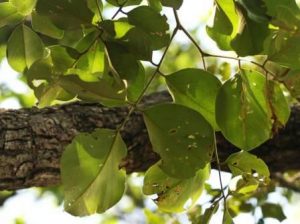
Pterocarpus rotundifolius. Photo: Bart Wursten. Source: Flora of Zimbabwe
After an excellent tea of scones, gingerbread and sausage rolls, we set off to view trees. On one side of the dam was the only specimen I saw of the round-leaved Mukwa, Pterocarpus rotundifolius. At a small, evilly low stream, our vehicle became bogged down. Our ever-resourceful host, assisted by all the men folk and some of the women, first dug, and then towed us out. We traversed many patches of sodic soils, with Colophospermum mopane. Many of these soils were flooded, as is their wont when it rains heavily.
On an apparently innocent-looking patch of sand, we bogged down again, and this time everybody heaved to, and stones and wood were collected. After more digging, the vehicle eventually was extricated. Now we had to disembark, take necessary luggage, and all were transported in the Land Rover to the delightful Mananda Dam, where we had a somewhat late lunch. This dam is fed by two rivers, and is very large. Because it is also used for agricultural irrigation, the dam is not entirely permanent and nearly always dries up in places in the winter when the rivers stop flowing.
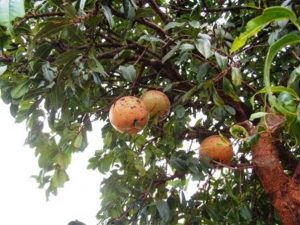
Strychnos pungens. Photo: Bart Wursten. Source: Flora of Zimbabwe
It was on the way to the Mananda Dam that Tessa identified a large specimen of Strychnos pungens, right on the road. I saw a single Faurea saligna, and Tessa caught a glimpse of a large teak tree, Baikiaea plurijuga. At one stop somebody said there were Cactus plants a small distance away. I gave careful instructions on how to differentiate between Cactus and Euphorbia. It turned out that the plants in question were neither Cactus nor Euphorbia, but Aloe excelsa.
Too soon, it was time for us to retrace our journey and return to our own vehicles. The Dudmans have a simply astounding garden, filled with Golden Rod, Spider Lilies, what used to be called Cosmos, Sunflowers and other goodies. As we approached this lovely place, one of the Go-away birds flew across the road. I was able to see clearly its bright red wings – no grey Lourie this, but its vastly superior, royal cousin – the Purple-crested Lourie! Another delicious tea was served and then we had to return to town. By now the floods had subsided, and we had no need to avail ourselves of an alternative route, thoughtfully instructed by our knowledgeable hosts.
John and Jill, we do thank you most sincerely for sharing with us your part of Paradise. We hope we were able to further your silvicultural study, and we would love to come again, if you’ll have us. Thanks are also due to Anthon for his leadership and for being our mentor.
-NORMA HUGHES
IN RETROSPECT
This month, April 2000, TREE LIFE celebrates its 20th birthday, and to mark the occasion we begin a series of notes and extracts from the earlier issues of the journal to recall past events and highlights of the Tree Society. Hopefully this series will be of interest to newer members of the Society, and take the older members on a pleasant excursion down memory lane. These extracts have been edited as thought nec¬essary, and periodic editorial notes (Comment 2000) have been added to update what was originally written.
Before the birth of TREE LIFE the Tree Society had produced a monthly newsletter with a pre-printed heading on the front page having it as The Bulletin of the Tree Society of Rhodesia. At the outset TREE LIFE was proposed as The Journal of the Tree Society of Zimbabwe, but obviously there were still stocks of headed front pages, and from April to August 1980 the heading remained as The Bulletin of the Tree Society of Rhodesia.
This was corrected to The Bulletin of the Tree Society of Zimbabwe in October 1980, the September issue having had no pre-printed heading. The now-familiar baobab logo first appeared in TREE LIFE No 150 (August 1992), and it was in this issue that the preprinted heading first appeared as The Journal of the Tree Society of Zimbabwe.
What’s in a name?
And what’s in a number? The consecutive numbering of each issue was fine to Number 8 (November 1980) – and then things began to happen! The issues of December 1980 and January 1981 both came out as Number 8, but the issue of February 1981 was back on track at Number 11. Smooth riding to Number 16 (July 1981), and then another hiccup in August 1981 when that issue came out as Number 18 instead of Number 17. And we have been one ahead of the original numbering sequence ever since! There was a bit of a glitch when the December 1983 and January 1984 issues were both numbered 46, but that was corrected in February 1984 when that issue came out as No.48.
At the end of 1981 members of the Tree Society received notifications that they would no longer automatically receive a copy of Zimbabwe Science News each month at subsidized rates. If they wished to continue receiving this journal they would have to pay an extra $4 per annum!
When TREE LIFE came into being there were three branches of the Tree Society – Mashonaland, Matabeleland, and Ayrshire. The first two are still in being, but the last mention of the Ayrshire Branch was made in TREE LIFE No. 112 (June 1989), in a report on an outing during the previous month.
There was also a Chegutu Branch from December 1983 to June 1989 – the last report on a Chegutu outing was published in TREE LIFE No.114 (August 1989). Both of the smaller branches seem to have ceased functioning with no record of actually disbanding.
Up to, and including, September 1995 all copy for TREE LIFE had to be painstakingly typed by ordinary typewriter, but in October 1995 there came the giant leap into modern communications technology when TREE LIFE No. 188 was put together in a computer and a two-column format was adopted. Most members will agree that this makes for much easier reading. Maureen, who has served continuously as the Tree Society’s Secretary since August 1988, now receives material for TREE LIFE by Email, diskette, typescript, and hand-written manuscript – but runners with cleft sticks have finally been phased out!
PROPELLER TREE
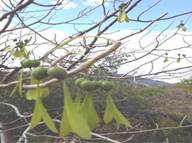
Gyrocarpus americanus, propellor tree. Photo: Plantz Africa
In TREE LIFE No.1 we read that “Gyrocarpus americanus caused discussion. It is the same species as occurs in South America and Australia and is just one of the many examples given as evidence of the Gondwanaland theory”. The propeller tree was still being discussed in TREE LIFE Nos. 229 and 230 (March and April 1999), and a note in the latter number covered the subject in some detail.
[Comment 2000: The “Gondwanaland theory” refers to the now widely accepted concept of plate tectonics and continental drift, and two interesting papers by Hiram Wild (first Professor of Botany at UZ) go into this subject in connection with southern African flora. The first of these papers was titled “Additional evidence for the Africa-Madagascar-India-Ceylon land-bridge theory with special reference to the genera Anisopappus and Commiphora”, and was published in Webbia 19 in 1965. The second, “Phytogeography in south central Africa” was published separately from Kirkia Vol. 6 Part 2, 1968. For those interested in the subject both papers should be available in the library at the Herbarium. The NATIONAL GEOGRAPHIC Magazine periodically publishes articles on continental drift, and perhaps the most comprehensive appeared in the issue of January 1973 under the title “This Changing Earth”.]
AN UNUSUAL USE FOR A TREE
An article under this heading in TREE LIFE No.2 (May 1980) is worth reproducing in full, but unfortunately there was no author’s name. We have all heard, I am sure, of the radiocarbon technique for dating samples of organic material up to 50 000 years old. To find the age of ancient organic material, the present content of radiocarbon is measured.
Then, knowing the rate of decay of the radiocarbon (half life about 5 730 years), and the original content, the age of the material can be calculated. To work out the original content, it is necessary to assume that the ratio of radiocarbon (C-14) to the other carbon isotopes (C-12 and C-13) has remained constant throughout the period concerned.
That this assumption was shaky was soon realized when it was found that the radiocarbon dates were consistently too young when material could be dated by other means. At the limit of historical dating (about 3100 BC) the discrepancy was as much as 700-800 years. Some means of improving the accuracy of the radiocarbon calendar was obviously needed. Pinus aristata, the bristlecone pine, which grows in the White Mountain region of California, provided one such means. The uniqueness of these trees lies in their annual-ring system. Reflecting the weather conditions, the rings form distinctive patterns. These patterns are repeated in all the trees, so that the rings of one tree can be accurately matched with those of another. What is more, the rings of a living tree can be matched with those of a dead tree, provided the dead tree was alive when the living one was young. Now, the bristlecone pine lives to a great age – up to 4 600 years has been recorded. Moreover, the annual rings, besides being distinctively patterned, are easily countable. So by taking core samples from both living and dead trees, and joining them at the point of match of the rings, it proved possible to achieve a continuous record of wood samples going back more than 8 000 years. These samples are, of course, easily datable by counting back to the relevant ring.
The radiocarbon calendar was then recalibrated by comparing the known ages of wood samples taken from these rings with that given by radiocarbon. As I understand it the recalibration has had a quite dramatic consequence for archaeology. The time scales have had to be lengthened considerably. It is now believed, for instance, that the European Bronze Age culture was not derived from the Greek (Mycenaean) culture at all, but preceded it by many years.
Another cherished belief that seems likely to be abandoned is the vision of Druids doing unmentionable things at Stonehenge! The age of the megalithic structures of Europe, including Stonehenge has had to be pushed back from 1800 BC to between 2500 BC and 3000 BC – long before the Celts entered Britain!
Not bad for a mere tree.
-LYN MULLIN In Retrospect – To be continued.
NYARUPINDA CATCHMENT
The Scene. AD. 2000 Anecdote.
At home at midnight we had a breather from London’s entertainment in the Dome, it was a clear night, from the west we heard fireworks from Ayrshire Club, and trees blocked the view of them. Seated we watched the south-eastern sky for movements in the heavens, shooting stars, satellites, anything, then there was a red thing, we both saw it, then it was gone. Later on in the day we learned that some farmers and their families camped on the level ground just below the summit of M’torcha kopjie on Kashwao Estate to see the New Year in, at 12.10 a.m. we had seen the red flare they put up. They watched the district’s pyrotechnics, nearby at Mutorashanga, Banket and as far as Trelawney Club. Many Tree Society members recall climbing this fine kopjie, it was strenuous.
Albizia tanganyicensis, very large was one of the many kinds of lofty trees there, deep pools in the rocks and Late Iron Age grain bins have a niche in the granite.
Development in the catchment.
Early in the New Year water from the Susuji dam began flowing in the pipeline to the Nyarupinda dam, the frogs applauded this event, and the gush of water extended their territory as it fanned out finding its way to the main body of water. They croaked all day and night until the novelty wore off and the pumping stopped. In view of the light and patchy rainfall in the Raffingora area so far this season, the timely completion of this project is reassuring in these troubled times.
Irrigation has been almost continuous this summer.
Chemurgy. Charcoal Production – Old and New.
This subject began in November 1999, Tree Life 237 page 8, by now you will have found out what chemurgy means, and also that its prime example is charcoal. This science has an American origin in the 1920’s and 1930’s.
Today’s recycling is largely a chemurgic process; this aims to supply industrial needs for raw material by finding naturally grown products or industrial by-products from which the required material comes, e.g. plastics from Soya beans, drugs for tranquilizers from Rauvolfia and Mexican yams, paper from straw, pepsin enzyme from paw-paw foliage; whisky and motor fuel from grains (carbohydrate), fabrics treated with a by-product are made into wash ‘n’ wear clothing. Charcoal and the diamond are forms of carbon, one shapeless and one crystalline. Partially burnt plant or animal material results in a porous black residue, light in weight, odourless. When lit it burns without much flame or smoke, it is safest when used out of doors, charcoal fuel fumes must be dispersed by good ventilation because they are dangerous.
Here is what happens when the char grill is lit: 2C+02 – 2CO + heat, you know these symbols in order: carbon, oxygen, carbon monoxide, the latter burning green. Air-dried wood (cellulose) produces carbon dioxide, water vapour and heat. The burning of most woods alters the mineral content to less than 1% ash. The earth and turf covered piles of green wood ‘steaming in the cool air’, was not steam (invisible) but dense white wet smoke given off in the charring process, water in the wood is escaping. The limited amount of air admitted when the wood has caught alight burns part of the wood, leaving a residue of charcoal. When the white smoke slows down, the fire is ‘stopped down’ with earth closing the vents at the base and almost closing the narrow top of the pile but leaving a small exit for smoke. When the contents settle the water is driven off. The critical moment is when the curl of white smoke becomes fine blue smoke which indicates that the charcoal has begun to burn, charring must stop, all air is excluded, more earth is added to the base, more sods on top to make it airtight. The process could take 72 hours, this may include cooling down. The end product is sieved, graded, weighed and bagged. The person in charge of the burning is a collier. Wood loses 80% of its weight when converted to charcoal.
Stick charcoal used for drawing is made from willow or vine twigs charred in special kilns. Coconut shells produce the cleanest and finest sample.
Articles in N.A.D.A. the Native Affairs Department Annual provide information on methods of making charcoal for iron smelting in Africa; it was very wasteful and destructive of trees. See volume IX No. 4 1967. Good quality charcoal was needed; the best source was Burkea africana or Terminalia.
Bantu tribesmen had three methods: they set fire to a stump at night allowing it to burn very hot, in the absence of wind, then throwing water on it before the stump was completely burnt out. A variation of this was throwing soil on to it and leaving it to cool for two days, without access to the atmosphere. A less destructive way was to burn the wood in bundles for two hours then water was thrown on it. Among the reams of notes the writer has amassed she has found that Keith Robinson found the earliest trace of iron working in this country, an English self-trained archaeologist. It was iron slag, in which charcoal occurs, at a small settlement near Chibi in 1961. Its radiocarbon date was AD 180 120 years. This place is west of Masvingo. The period was the Early Iron Age; these people were probably those of the Gokomere Tradition whose pottery was some of the earliest made here. For firing pots a charcoal of softer wood provided a lower temperature for this procedure.
In conclusion here is something that has a bearing on this subject. My mother’s ancestor in the 17th century was John Fuller Ironmaster of Crowhurst in Sussex. This family had humble beginnings but came to be allowed a coat of arms, usually only the prerogative of nobility, the family motto was fitting, ‘Carbone Et Forcibus’ … By Charcoal and Tongs.
There is one point which must be added which is that the destruction of trees for charcoal served the purpose clearing areas where subsistence crops were grown, finger millet, sorghum, pumpkins and beans.
Modern Charcoal Production is large scale using retorts for dry distillation of wood; its by-products are valuable chemurgic materials such as tars and acids. The raw material is twenty-year-old coppice grown for this purpose, it is self-sustaining. The coppice boles are the home of numerous small mammals as well as mosses and lichens.
Happy Wandering
-Benedicta Graves
CAESAR PASS 20 FEB 2000
The Caesar Pass road was not at its best after the heavy rains influenced by the effects of Cyclone Eline battering the eastern and southern parts of the country. However, with a few scrapes over a stream rutted approach and a left turn brought us into thick riverine woodland with palms Phoenix reclinata following the streams and the canopy being mostly Syzygium guineense, the waterberry. There is high magnesium versus calcium levels in the area which seems not to bother the plants but is reputed to have effects on the human intestinal tract for a few days. We were also delighted to have some guests from Belgium with us, namely Prof. Malaisse and his two assistants who were in Zimbabwe to study the effects of mineralised soils on vegetation.
With Prof. Malaisse’s keen botanical eye and Derek Henderson’s knowledge of pedology we headed slowly along a well-used road.
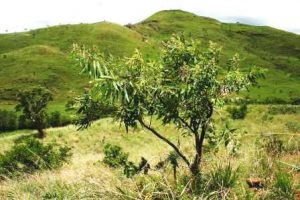
Ozoroa longipetiolata . Photo: Bart Wursten. Source: Flora of Zimbabwe
Noting the contact zones of mineralised soils often indicated with jagged pieces of greenish serpentine pointing through the shallow soil and the mineral tolerant plant species such as the attractive Dyke Ozoroa – Ozoroa longipetiolata and the extremely adaptable Rubber tree Diplorhynchus condylocarpon. The less toxic soils and intrusions of ironstone support more typical vegetation such as Miombo woodland, with Brachystegia glaucescens, Brachystegia spiciformis and Julbernardia globiflora. A casual look at the surrounding hills in summer colours give a much softer appearance than the tan colours of winter and early spring. Bob Drummond’s Trees of the Central Watershed Woodlands proved itself useful once again as a small shrubby colony of Acacia-like regrowth quickly proved themselves to be Elephantorrhiza sp., which has a massive rooting system as the name suggests. The midrib close to the upper margin seemed to indicate that this might be Elephantorrhiza suffruticosa, but there seems to be doubt. The question remains can anybody remember what it actually looked like, as I made no notes and am relying on memory.
Since our last visit some 7 years ago, outwardly there seemed little change, perhaps Anne Hatley could advise, except that the indication of mining is more apparent as lumps of black chrome ore dropped by co¬operative mine workers are scattered along the roadside. These cooperative mines, while providing a ‘hard earned income’ for those doing the backbreaking task of digging heavy ore from the unstable serpentines, have little or no regard for safety. At the end of the mornings walk as witnessed where the entrance to a disused shaft was at the point of collapse. Another ‘interesting ‘ feature was the use of an Erythrina log as a cross member of the crudely assembled timber supports – I do not recall this species being noted for the strength of its timber! These co-op miners must have nerves of steel or have reached desperation to enter such unsafe places, not forgetting the water dripping from the saturated rocks above. On the grassy slope above the stope entrance, a scattered colony of the interesting Euphorbia wildii, another Dyke endemic is to be found.
A most attractive place with the streams in full flow and our apologies to Anne Hatley for thinking that the site was in the Caesar Mine property.
-Andy MacNaughtan
THE GIANT POMPON TREE
The species was named by Linnaeus from a specimen grown in Holland by David van Royen, Professor of Botany at Leyden, and which flowered in 1757 …It is a fascinating fact that he knew the tree in the 1760s when the countryside it came from was virtually unexplored.
EVE PALMER & NORAH PITMAN (1972-73) – TREES OF SOUTHERN AFRICA
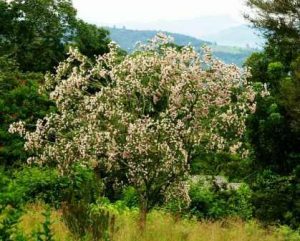
Dais cotinifolia . Photo: Bart Wursten. Source: Flora of Zimbabwe
It is only quite recently that the pompon tree, Dais cotinifolia (Thymelaeaceae), has become a popular urban ornamental in Zimbabwe, or anywhere in southern Africa, yet it has been cultivated in Europe for more than 200 years. Its natural range is from round East London on the South African coast northwards to the north-eastern Transvaal, with an ex¬tension to the Eastern Highlands of Zimbabwe. Seed was collected in South Africa in about 1749 and sent to Holland, where Professor David van Royen raised it. He called it Dais – torch – because the long-stalked, pink flower heads looked for all the world like torches about to be lit. The great Swedish botanist, Linnaeus (Carl von Linné), adopted van Royen’s generic name for the plant, and he gave it the specific name cotinifolia because of the resemblance of its leaves to those of members of the genus Cotinus (Anacardiaceae).
The pompon tree in Zimbabwe is often no more than a shrub or small tree 3-4 metres tall, occasionally up to 13 metres, but it reaches much larger sizes in the Chimanimani district. On the road from Chimanimani village to Bridal Veil Falls is the “Little Waterfall”, and in the valley about 200 metres below this fall there is a particularly large specimen with five main stems arising from the base. In December 1986 it had a diameter of 84.4 cm at ground level, and the two largest of the five stems had breast-height diameters of 46.3 cm and 36.7 cm respectively. The tree was 21 m tall. Up and down the stream from this tree were others of the species with diameters of 30-40 cm and heights up to 16 metres.
-Lyn Mullin
Root Note
An anti-fungal drug to help to control athlete’s foot and thrush is to be developed from the roots of Swartzia madagascariensis, a tree found in Zimbabwe. The substance is found on the bark of the roots and evolved in order to protect the tree against soil-borne fungi, Dr. Kurt Hostettmann, of the University of Lausanne, said.
The Times
ANDY MACNAUGHTAN CHAIRMAN


